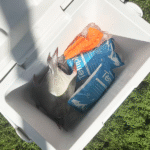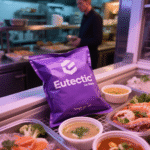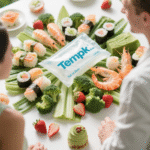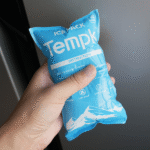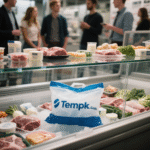Vaccine Cold Chain Management: Comment assurer la sécurité des vaccins
Mis à jour: 26 November 2025
Efficace vaccine cold chain management is the backbone of safe immunization. Without rigorous temperature control and monitoring, vaccines can lose potency long before they reach your clinic. Most vaccines must be stored between 2 °C et 8°C throughout production, transport and administration. The World Health Organization warns that up to 50 % of vaccines are wasted globally due to inadequate cold chain logistics. Dans ce guide, vous apprendrez à concevoir, manage and optimise vaccine cold chains to protect public health, comply with regulations and adapt to emerging trends in 2025.

Why vaccine cold chain management matters – understand how narrow temperature ranges, freeze sensitive ingredients and heat exposure affect vaccine potency and why poor cold chains lead to high wastage.
How to build a robust vaccine cold chain – explore essential components like purpose built refrigerators, emballage isolé, digital data loggers and trained personnel.
What to do when temperatures deviate – learn emergency procedures, documentation practices and quality assurance protocols for temperature excursions.
Which innovations shape cold chain management in 2025 – discover trends such as automation, durabilité, suivi en temps réel, artificial intelligence and the controlled temperature chain concept.
Frequently asked questions about vaccine cold chain management – get concise answers about storage ranges, surveillance, Technologie IoT, emergency response and new solutions.
Why Is Vaccine Cold Chain Management Essential for Potency?
Réponse directe
Vaccine cold chain management ensures that vaccines remain within their prescribed temperature range, typically 2 °C–8 °C, from manufacturer to patient, preventing irreversible degradation. Biological components in vaccines—proteins, peptides or mRNA strands—are fragile and quickly lose effectiveness when exposed to heat or freezing conditions. Poor cold chain practices lead to potency loss and can trigger costly recalls or revaccination campaigns.
Explication élargie
Imagine leaving ice cream in the trunk of your car on a hot day: even if you refreeze it later, the texture and taste change. Vaccines behave similarly. They contain delicate molecules that break down when temperatures drift outside the recommended window. Heat exposure above 8 °C accelerates the breakdown of active components, alors que freezing below 0 °C can permanently damage freeze sensitive vaccines containing aluminium adjuvants. Unlike spoiled food, you cannot see or smell a compromised vaccine; continuous monitoring is the only reliable indicator of quality. Without proper management you risk administering ineffective doses, wasting resources and jeopardising community immunity. Dans 2025, with supply chains stretched by global immunisation campaigns, robust cold chain practices have become non negotiable.
Understanding Vaccine Temperature Requirements and Categories
Vaccines fit into several temperature categories depending on their formulation and stability. Routine vaccines for measles, tetanus or hepatitis B remain stable when refrigerated at 2 °C–8°C. mRNA based vaccines and some gene therapies require ultra low storage, often between −90 °C and −60 °C, to protect fragile nucleic acids. Emerging thermostable vaccines approved for controlled temperature chain (CTC) use can tolerate ambient conditions up to 40 °C for three days. Understanding these categories helps you choose suitable equipment and packaging.
| Catégorie de température | Gamme typique | Example Vaccines | Importance |
| Réfrigéré | 2 °C–8°C | Rougeole, hépatite B, DPT | Maintains potency of most routine immunisations and reduces wastage |
| Congelé | −50 °C–−15 °C | Varicella containing vaccines | Long term stability; requires separate freezers and careful handling |
| Très froid | −90 °C–−60 °C | vaccins d'ARNm (Par exemple, some COVID 19 vaccines) | Preserves fragile mRNA molecules and supports global distribution |
| CTC (Ambiant) | Up to +40 °C for a limited time | Selected thermostable vaccines | Allows single ambient excursion during campaigns, reducing logistical burdens |
Astuces et conseils pratiques
In remote clinics: Investir dans solar powered, purpose built refrigerators to maintain 2 °C–8 °C even when electricity is unreliable. Choose units with internal batteries and energy efficient compressors.
Pendant le transport: Utiliser insulated containers with phase change materials that maintain safe temperatures for at least 72 hours. Pre condition packs at the correct temperature and avoid opening containers unnecessarily.
In community pharmacies: Installer digital data loggers with continuous recording and alarm functions. Choose devices that provide remote alerts via SMS or email so you can act promptly when a temperature excursion occurs.
Cas du monde réel: A rural health centre in East Africa implemented solar powered refrigerators and IoT temperature sensors. By receiving alerts whenever temperatures drifted, staff intervened quickly—moving vaccines to backup coolers or replacing faulty equipment. This proactive approach cut vaccine wastage by nearly 30 % within a year and improved community trust in immunisation services.
How to Build a Robust Vaccine Cold Chain System in 2025
Réponse directe
A robust vaccine cold chain integrates specialised storage equipment, appropriate packaging, surveillance continue, trained personnel and contingency planning. Purpose built refrigerators and freezers maintain the required temperatures, insulated packaging and phase change materials protect vaccines during transport, and digital data loggers provide continuous temperature records. Staff training and clear standard operating procedures ensure consistent handling and prompt response to any deviations.
Explication élargie
Building a vaccine cold chain is like orchestrating a symphony: every instrument must play in harmony. Storage units are the foundation. Les États-Unis. Centres de contrôle et de prévention des maladies (CDC) recommends purpose built or pharmaceutical grade refrigerators and freezers that maintain 2 °C–8 °C for refrigerated vaccines et −50 °C to −15 °C for frozen vaccines. Avoid dormitory style refrigerators because they have temperature fluctuations and risk freezing.
Appareils de surveillance de la température (TMDs) are your eyes and ears. WHO guidelines stipulate that vaccines should be continuously monitored at every level of the supply chain. Digital data loggers record temperatures every few minutes and provide alerts when thresholds are breached. Dans 2025, many logistics providers pair sensors with plateformes blockchain, creating immutable temperature records and enhancing traceability.
Packaging solutions come next. Insulated shipping containers lined with phase change materials or dry ice maintain stable temperatures during transit. For routine vaccines, gel packs conditioned between 2 °C and 8 °C suffice. Ultra cold shipments use dry ice or liquid nitrogen. Packaging must minimise air gaps, limit heat transfer and include temperature indicators or vaccine vial monitors.
Transport involves refrigerated trucks, cargo aircraft with climate controlled containers and pre cooled vehicles. Route planning matters: shorter transit times reduce exposure to external conditions. During last mile delivery, ensure that vehicles remain closed and shaded, and that cold boxes are not exposed to direct sunlight.
People and procedures glue the system together. Designate a vaccine coordinator responsible for ordering, receiving, storing and monitoring vaccines. Train all staff involved in immunisation to follow standard operating procedures (Sops) for routine handling and emergencies. Review SOPs annually and update them when adding new vaccines or equipment.
The Role of IoT and Real Time Monitoring in Vaccine Cold Chain
L'Internet des objets (IoT) has transformed cold chain management from a labour intensive process into an automated, proactive system. Real time tracking devices use sensors to monitor temperature, humidity and light exposure every minute. They send alerts when thresholds are breached and record data for compliance. Dans 2025, IoT platforms integrate with intelligence artificielle (IA) to predict potential equipment failures and route delays before they occur. AI analyses historical data and weather forecasts to recommend optimal routes and packaging materials, reducing both spoilage and emissions.
Astuces et conseils pratiques
Large hospitals: Integrate IoT temperature sensors with your hospital information system. Central dashboards allow administrators to view all storage units, receive alerts and coordinate maintenance.
Prestataires logistiques: Utiliser analyse prédictive to optimise routes. AI can forecast traffic, weather and equipment performance, suggesting alternative routes or additional dry ice packs to prevent temperature excursions.
Sustainability champions: Investir dans emballage réutilisable made from biodegradable materials or recyclable insulation. Sustainable cold chain solutions reduce waste and meet stricter environmental regulations.
Cas du monde réel: A national immunisation programme adopted blockchain enabled data loggers for vaccine shipments. Each shipment’s temperature history was recorded in real time. If a sensor detected a deviation, an automated alert informed the nearest health facility to prepare backup storage. Over 12 months, the programme saw a 40 % reduction in temperature excursions and improved transparency during audits.
Managing Temperature Excursions and Ensuring Compliance
Réponse directe
When a temperature excursion occurs, immediate action, documentation and quarantine are essential. Exposed vaccines should be labeled “Do Not Use,” segregated in the storage unit and assessed for viability. Facilities must notify their vaccine coordinator, documenter l'incident, implement emergency procedures and consult their immunisation programme or manufacturer for guidance.
Explication élargie
Despite rigorous controls, pannes de courant, equipment failures and human error can lead to temperature excursions. The CDC advises checking and recording minimum and maximum temperatures at the start of each workday. If using a device without min/max display, record the current temperature at least twice daily. Monitoring logs should include the date, temps, person recording, temperatures and any corrective actions.
When a deviation is detected:
Notify the vaccine coordinator or supervisor immediately.
Quarantine the affected vaccines by labeling them “Do Not Use” and placing them in a separate container within the appropriate storage unit; do not discard them until the manufacturer or health authority determines viability.
Document the event thoroughly, noting the duration of the excursion, temperatures recorded and steps taken.
Mettre en œuvre des SOP for emergencies, which may include moving vaccines to a backup unit, adjusting thermostat settings or calling maintenance.
Consult your immunisation programme or vaccine manufacturer to decide whether to continue using or discard the vaccines. Regulatory bodies may require complete temperature records for audits.
Entraînement is equally vital. Staff should know how to operate monitoring devices, interpret alarms and respond quickly. Continuous education, annual refresher courses and competency assessments ensure that procedures are followed correctly.
Standard Operating Procedures for Temperature Excursions
Standardising your response reduces confusion when every second counts. SOPs should cover:
Equipment maintenance – schedule regular calibration and servicing of refrigerators, freezers and data loggers. Keep spare parts and backup units on hand.
Emergency power – install generators or battery backups to maintain temperature control during outages. Test these systems quarterly.
Alternative storage – pre identify nearby facilities or mobile cold boxes where vaccines can be temporarily stored.
Communication protocols – designate contacts at local health departments and manufacturers. Ensure everyone knows whom to call when excursions occur.
Astuces et conseils pratiques
During power failures: Do not open storage unit doors. Connect generators promptly and verify that temperatures return to safe ranges. Use cold packs or dry ice only if recommended by the manufacturer.
When sensors alarm: Check device placement—thermometer probes should be inside the storage compartment, away from vents and doors. If the alarm persists, document the reading and isolate the vaccines.
After the incident: Review your logs and SOPs to identify root causes. Implement corrective actions, such as adjusting thermostat settings or training staff.
Cas du monde réel: A city clinic experienced a refrigerator failure overnight. Thanks to continuous monitoring, staff received an alert at midnight. They moved vaccines to a backup unit within 30 minutes, documented the excursion and contacted the manufacturer. After quality tests, most of the vaccines were cleared for use. The clinic’s emergency plan prevented the potential loss of thousands of doses and maintained patient trust.
2025 Vaccine Cold Chain Trends and Innovations
Présentation des tendances
The vaccine cold chain landscape is evolving rapidly. Dans 2025, industry experts highlight several trends driving improvements in efficiency, durabilité et résilience:
Automatisation et robotique – Cold storage facilities are adopting automated storage and retrieval systems and robotic handlers. These machines operate around the clock, reduce labour costs, improve accuracy and provide consistent temperature control. With approximately 80 % of warehouses still unautomated, the potential for growth is significant.
La durabilité comme valeur fondamentale – Energy efficient refrigeration systems, renewable power sources and biodegradable or recyclable packaging are now essential. The global food cold chain contributes about 2 % des émissions mondiales de CO₂, prompting companies to adopt sustainable practices.
Visibilité de bout en bout – IoT enabled tracking devices provide real time insight into location, température et humidité. This visibility allows logistics providers to optimise routes, prevent spoilage and meet regulatory requirements.
Modernising infrastructure – Investments in modern refrigeration, improved insulation and on site renewable energy help ageing facilities meet efficiency and sustainability standards.
IA et analyse prédictive – Artificial intelligence analyses historical and real time data to predict equipment failures, forecast demand and optimise routes. Predictive models recommend when to replenish dry ice or adjust delivery schedules, reducing risk and cost.
Growth in the pharmaceutical cold chain – The pharmaceutical sector drives expansion of cold chain logistics. Environ 20 % de nouveaux médicaments sont des thérapies géniques ou cellulaires nécessitant un stockage ultra froid. The global pharmaceutical cold chain market is projected to reach US$65 billion in 2025 and double by 2034.
Partenariats stratégiques et intégration – Collaboration between manufacturers, logistics providers and technology companies enhances visibility and resilience. Data standardisation and smart containers enable seamless integration across supply chains, avec 74 % of logistics data expected to be standardised by 2025.
Controlled Temperature Chain (CTC) – WHO’s CTC approach allows certain thermostable vaccines to be kept at ambient temperatures up to 40 ° C for a limited time before administration. This strategy reduces dependence on refrigerated transport in remote areas and supports mass immunisation campaigns.
Derniers développements en un coup d'œil
Robotic cold storage: Automated systems are reducing human error and increasing throughput, providing consistent temperature control and enabling 24/7 opérations.
Emballage écologique: Companies are switching to isolation biodégradable and reusable phase change materials, cutting waste and carbon emissions.
Maintenance prédictive: AI monitors equipment to schedule maintenance before breakdowns occur, minimizing downtime and preventing excursions.
Congélateurs ultra bas: New ultra low temperature freezers use less energy and handle mRNA vaccines more efficiently, supporting the growth of gene therapies.
Transparence de la blockchain: Immutable temperature records build trust with regulators and donors, ensuring accountability throughout the vaccine journey.
Insistance au marché
The cold chain market continues to expand. Le pharmaceutical cold chain sector is projected to exceed US$65 billion in 2025. Growth is driven by vaccines, biologics and personalised gene and cell therapies, many of which require ultra cold or highly controlled conditions. With nearly 20 % de nouveaux médicaments demanding such storage, investment in infrastructure, advanced monitoring and sustainable technologies is critical. En même temps, cold chain infrastructure currently accounts for about 2 % of global CO₂ emissions, creating pressure to adopt energy efficient systems. Companies that balance stringent temperature control with sustainability will lead the market in the coming decade.
Questions fréquemment posées
Q1: What temperature range must vaccines be kept at during storage and transport?
Most routine vaccines must remain between 2 °C et 8°C from manufacturing through administration. Some vaccines require ultra cold conditions—mRNA based COVID 19 vaccines, par exemple, may need storage at −70 °C to −60 °C. Always follow the temperature specified by the manufacturer and monitor continuously.
Q2: Why are vaccine cold chains different from general refrigerated chains?
Vaccine cold chains maintain a narrow temperature band and monitor continuously because biological components degrade quickly when exposed to heat or freezing. Food cold chains tolerate wider ranges and focus on preventing spoilage. Vaccine cold chains also require specialized packaging, manipulation minutieuse, and regulatory documentation.
Q3: How do IoT sensors help maintain the vaccine cold chain?
IoT sensors record temperatures in real time and send alerts when thresholds are breached. They create continuous data logs that regulators require and integrate with AI to predict issues before they happen. This proactive approach reduces waste, optimises routes and improves compliance.
Q4: What should I do if my vaccine fridge temperature goes out of range?
Immediately label the vaccines “Do Not Use,” quarantine them and notify the vaccine coordinator. Documenter l'incident, record all temperatures, and follow your emergency SOPs. Contact your immunisation programme or the manufacturer to determine whether the vaccines remain viable.
Q5: What innovations are shaping vaccine cold chain management in 2025?
Les innovations clés incluent automation and robotics, emballage durable, suivi en temps réel, Analyse prédictive basée sur l'IA, modernized infrastructure, et le controlled temperature chain approche. These technologies improve efficiency, reduce waste and support remote immunisation campaigns.
Résumé et recommandations
Principaux à retenir
Le contrôle de la température est essentiel – Vaccines must remain within their specified temperature range (usually 2 °C–8 °C) to retain potency. Both freezing and heat can permanently damage vaccines.
Continuous monitoring prevents waste – Digital data loggers provide real time temperature records and alerts, ensuring that deviations are caught early.
Robust infrastructure matters – Purpose built storage units, emballage isolé, trained personnel and clear SOPs create a reliable cold chain.
Emergency preparedness saves doses – Quarantine affected vaccines, document excursions and consult experts before discarding.
Innovation drives improvement – Automation, durabilité, IoT and AI are transforming cold chain logistics, while CTC strategies broaden access in remote areas.
Plan d'action
Audit your existing cold chain: Evaluate storage equipment, packaging protocols, monitoring devices and SOPs. Identify gaps and invest in purpose built refrigerators, freezers and continuous monitoring.
Mettre en œuvre la surveillance de l'IoT: Deploy sensors that provide real time temperature and location data. Integrate these systems with AI to predict maintenance needs and optimise routes.
Develop and rehearse SOPs: Create clear procedures for routine handling and emergencies. Train staff annually and maintain updated contact lists for manufacturers and health authorities.
Adopter des pratiques durables: Transition to energy efficient refrigeration, biodegradable packaging and renewable power sources to reduce your carbon footprint and meet regulatory expectations.
Stay informed on trends: Monitor developments in automation, analyse prédictive, CTC and regulatory changes to keep your cold chain competitive.
À propos du tempk
Tempk is a leading provider of cold chain solutions dedicated to preserving the integrity of temperature sensitive products. Nous concevons purpose built refrigeration systems, emballage isolé et IoT enabled monitoring devices tailored to the needs of pharmaceutical, industries biotechnologiques et alimentaires. Our research and development centre focuses on sustainable materials and energy efficient technology, enabling clients to reduce waste and carbon emissions. With a strong track record of supporting global immunisation campaigns and life science logistics, we help our partners deliver safe, potent vaccines around the world.
Étapes suivantes: Explore how Tempk’s solutions can enhance your vaccine cold chain. Contact our experts for a personalised assessment and discover the tools that will keep your vaccines safe in 2025 et au-delà.

















